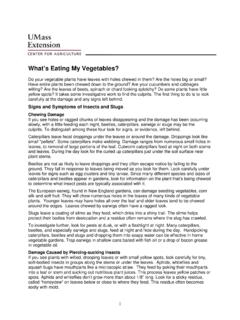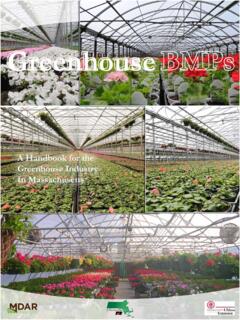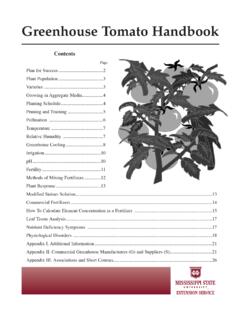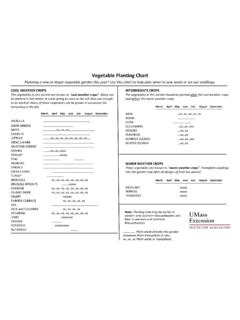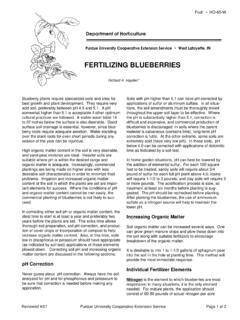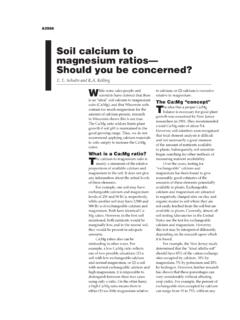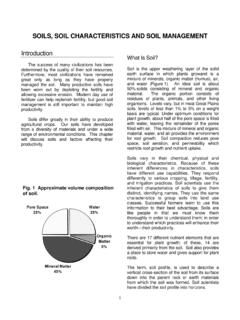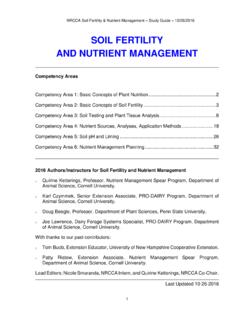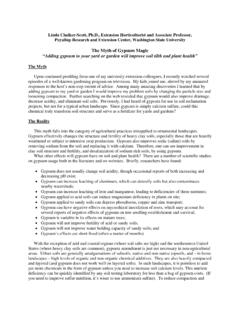Transcription of Interpreting Your Soil Test Results - The Center for ...
1 soil and Plant Nutrient Testing Laboratory 203 Paige Laboratory 161 Holdsworth Way University of Massachusetts Amherst, MA 01003. Phone: (413) 545 2311. e mail: website: Interpreting your soil Test Results T he primary goal of soil testing is to inform efficient and effective resource management. soil testing is the most accurate way to determine lime and nutrient needs. soil testing is also useful for identifying contaminated sites ( , elevated levels of lead). can occur. Phosphorus enrichment is a leading source of water quality impairment of many lakes, streams, and rivers in New England.
2 soil phosphorus exists in a wide range of forms. Some phosphorus is present as part of soil organic matter and The Results provided on your soil test report reflect the becomes available to plants as the organic matter properties of the sample you submitted and the testing decomposes. Most inorganic soil phosphorus is bound procedures used by the University of Massachusetts soil tightly to the surface of soil minerals ( , iron and and Plant Tissue Testing Laboratory. The analytical aluminum oxides). Warm, moist, well-aerated soils at a pH.
3 Methods used by the laboratory were developed for climate level of about optimize the release of both of these and soil types common to New England and the forms. Plants require fairly large quantities of phosphorus, Northeastern is important to recognize that the values but the levels of phosphorus available to plant roots at any obtained when a soil sample is analyzed are of little use given time are usually quite low.. soil tests attempt to assess as raw analytical data. In order to make use of the values in the ability of soil to supply phosphorus from bound forms predicting nutrient needs, the test must be calibrated by during the growing season.
4 When a soil test indicates that conducting nutrient response research under local phosphorus is low and fertilizer is needed, the rate conditions with representative soils ranging from deficient recommended is intended to satisfy immediate crop needs to adequate for each nutrient of concern. The optimum and begin to build soil phosphorus levels to the optimum range (or typical range in some cases) is provided in the range ( , build and maintain). Phosphorus column to the right of your Results . These interpretations, as recommendations are customarily expressed as P2O5 to well as lime and fertilizer recommendations, are based on correlate with fertilizer analysis.
5 Once soil test levels are in field and greenhouse trials conducted in Massachusetts and the optimum range, only a small amount of phosphorus is other Northeastern provided with needed to replace removal and maintain soil levels. your soil test report are specific to the crop selection that If your soil test Results indicate above optimum you identified on your soil sample submission form and are levels, phosphorus application is unnecessary and should be based on the analytical Results for your sample. The purpose limited. Where soil phosphorus levels are excessive, of this fact sheet is to provide a brief explanation of each of phosphorus application should be eliminated, and additional the values provided on your soil test report and how they are steps should be taken to minimize the risk of surface water used to generate recommendations.
6 Contamination by limiting runoff losses. soil TEST Results . Potassium (K) Potassium rivals nitrogen as the nutrient Modified Morgan Extractable Nutrients: absorbed in greatest amounts by plants. Like nitrogen, crops The lab uses the Modified Morgan extraction procedure, take up a relatively large proportion of plant-available originally developed at the University of Connecticut in the potassium each growing season. Plants deficient in early 1930s for use on New England Soils. It is a universal potassium are unable to utilize nitrogen and water extraction procedure, meaning it is used to determine all efficiently and are more susceptible to disease.
7 Most major nutrients and many of the micronutrients available potassium exists as an exchangeable cation (see simultaneously. Nearly all of the New England State below). The slow release of potassium from native soil Universities and Cornell use the Morgan extraction minerals and from fixed forms in clays can replenish some procedure. of the potassium lost by crop removal and leaching. This ability, however, is limited and variable. Fertilization is Phosphorus (P) Among other important functions, often necessary to maintain optimum yields.
8 Phosphorus provides plants with a means of using the energy harnessed by photosynthesis to drive its metabolism. When a soil test indicates that fertilizer potassium is A deficiency of this nutrient can lead to impaired vegetative required, the rate of fertilizer recommended is intended to growth, weak root systems, poor fruit and seed quality, and satisfy crop needs and build soil potassium levels to the low yield; however, excessive soil phosphorus levels are a optimum range. Sandy soils with very low CEC will tend to concern due to the potential negative impact on surface lose substantial quantities due to leaching and will require water quality.
9 Most phosphorus losses occur with runoff, more frequent applications of fertilizer. Even when soils test but where soil levels are extremely high, subsurface losses in the optimum range, some potassium generally is recommended to account for a portion of crop removal. By aluminum levels, whereas lettuce, carrots and beets are very convention, potassium recommendations are expressed as sensitive. Extractable aluminum increases greatly at soil pH. K2O to correlate with fertilizer analysis. below Proper liming will lower aluminum solubility to acceptable some crops, the amount of P2O5.
10 calcium (Ca) calcium is essential for proper functioning fertilizer recommended is adjusted based on extractable of plant cell walls and membranes. Sufficient calcium must aluminum levels. also be present in actively growing plant parts, especially in fruits and roots. Properly limed soils with constant and Lead (Pb) This laboratory routinely screens all soil samples adequate moisture will normally supply sufficient calcium for elevated levels of extractable extractable lead to plants. If soil calcium levels are less than optimal and level is used to estimate the concentration of total sorbed lime is not required, gypsum ( calcium sulfate) may be lead, which is what MassDEP and USEPA guidelines are recommended.
